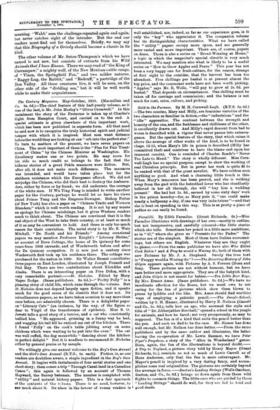Piccalilli. By Edith Farmiloe. (Grant Richards. 6s.)—Miss Farmiloe illustrates with
drawings of her own—mostly in outline, but not inexpressive, and carefully coloured—the little stories which she tells. Sometimes her pencil is a little more ambitious, as in "47," where she gives us "Presents for the Padre." The stories are of the simplest. Most of them have Italian surround- ings, but others are English. Whatever they are they ought to please.—From the same publisher we have also Who Kilted Cock Robin? and A Frog he would a Wooing Go, both of them with new Pictures by Mr. J. A. Shepherd. Surely the true text is "Froggy would a Wooing Go" ?—The Diverting History of John Gilpin appears again, with Pictures by A. S. Forrest (Dean and Son). These pictures are not without humour, but we have seen better and more appropriate. They are of the babyish kind, and John Gilpin is not meant for babies.—Ten Little Boer Bays. By Mrs. Ernest Ames. (Same publishers. 3s. 6d.)—We have no inordinate affecticn for the Boers, but we must own to not caring for the fun of pictures which show them blown to pieces by lyddite and the like. Mrs. Ames should find worthier ways of employing a patriotic pencil.—The Jungle-School, written by S. H. Hamer, illustrated by Harry B. Neilson (Cassell and Co., is. 6d.), tells how an ape, who assumed the style and title of "Dr. Jibberjabber Burchall," opened a school in the jungle for animals, and how he fared ; not very prosperously, as may be supposed. The fun is of a kind that suits the pencil better than the pen. And such we find to be the case. Mr. Hamer has done well enough, but Mr. Neilson has done better.—From the same publishers and by the same author and illustrator, the latter having the co-operation of Mr. Lewis Baumer, we have Peter Piper's Peepshow, a story of the "Alice in Wonderland" genus. Here, again, the fun of the illustrations is beyond doubt.— 21 Trip to Toyland, a picture story told by Henry Mayer (Grant Richards, Os.), reminds us not so much of Lewis Carroll as of Hans Andersen, only that the fun is more extravagant. Mr. Mayer's pencil is inspired by a very daring fancy, and accom- plishes some real originalities. The pictures are certainly beyond the average in force. —Dartcrn's Leading Strings (Wells Gardner, Darton, and Co., is. 6d.) brings us down again from these wild flights to common things. The little ones who are guided by these " Leading Strings" should do well, for they are led to kind and good deeds.






















































 Previous page
Previous page